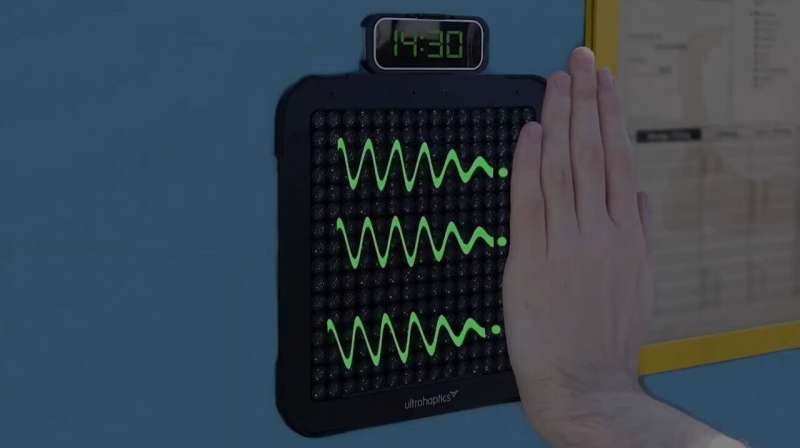June 4, 2020 report
Digital Braille speaker communicates using mid-air pulses

Researchers at Bayreuth University have developed a digital-age speaker system that permits the blind to read Braille using ultrasound waves in mid-air.
Instead of either fixed or refreshable physical dots, the HaptiRead system relies on precisely focused tiny puffs of air generated by acoustic force.
"With HaptiRead, we investigate for the first time, in a user study with blind people, the possibility of using midair haptic technology for the purpose of presenting Braille text as a touchless haptic sensation," said Bayreuth researcher Viktorija Paneva. "Midair haptic devices consist of an array of phased ultrasonic speakers. By modulating the focused ultrasonic waves, it is possible to generate perceivable haptic points in midair. The sensation is usually described by users as a focused, gentle air breeze."
The HaptiRead device is composed of a 16 x 16 grid of ultrasound mini speakers that project air blasts. It uses a Leap Motion sensor to detect an approaching hand. The device can communicate with an individual up to just under 2 1/2 feet away.
In addition to the enormous challenges the sightless face undertaking some of life's simplest tasks, they also must contend with special challenges a more digitized world creates.
The authors of the report "HaptiRead: Reading Braille as Mid-Air Haptic Information" describe scenarios the blind face daily with interactive tasks:
"It is more difficult for the blind to maintain their personal privacy when engaging with public displays. Audio feedback is easily overheard by bystanders and can be perceived as obtrusive, since it contributes to the environmental noisescape. Some interfaces, such as ATMs, feature a headphone plug. In this case, however, users need to remember to bring headphones and once they start the interaction, they might have more difficulty monitoring events in their surroundings."
The report adds that refreshable Braille displays have limitations as well. Such displays consisting of lines of pins creating dot patterns are "suitable for text, but not sufficient for content involving shapes and objects" such as graphs and charts.
And in this age of COVID-19, there is heightened concern over frequent physical contact with Braille interfaces found in banks, stores, hospitals.
With accuracy rates in their tests of between 88 percent and 94 percent, the developers say more work needs to be done. The HaptiRead system is limited to four cells of dot combinations for now, but will need to be expanded to six cells to more fully accommodate all sounds.
"We hope that our study will spark research into using mid-air haptics to potentially make the everyday multisensory experience of visually impaired and blind people richer," the developers say.
Braille's origins go back 199 years, when Charles Barbier, a French soldier responding to the great French military commander Napoleon's call to develop a means of communicating silently during the night, devised a system of 12 dot patterns representing 36 sounds. A student at the French Royal Institution for Blind Youth in Paris named Louis Braille was intrigued by the system and at the age of 15 offered several areas of improvement. His approach was ultimately accepted and a language that would ultimately bear Braille's name would go on to be used for two centuries.
Napoleon was a pretty big deal in the 1800s, winning most of his battles during the Napoleonic wars forging one of the greatest empires in the world and garnering praise as one of history's greatest commanders. Who knows how much more he could have accomplished with a pair of Air Buds and HaptiRead?
More information: HaptiRead: Reading Braille as Mid-Air Haptic Information, arXiv:2005.06292 [cs.HC] arxiv.org/abs/2005.06292
© 2020 Science X Network
















